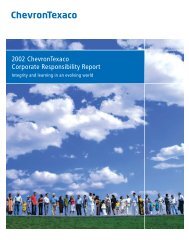Next* Magazine, Issue 5 - Chevron
Next* Magazine, Issue 5 - Chevron
Next* Magazine, Issue 5 - Chevron
Create successful ePaper yourself
Turn your PDF publications into a flip-book with our unique Google optimized e-Paper software.
PHOTOS: BOTTOM LEFT, KEN CHILDRESS; TOP RIGHT, MARC MARRIOTT<br />
While a <strong>Chevron</strong> drilling rig bores down<br />
8,000 feet (2,438 m) below southwestern<br />
Pennsylvania to unlock natural gas trapped in<br />
dense shale rock, Tim Svarczkopf monitors the mobile<br />
water-treatment technology he invented.<br />
“The process takes black, viscous water that flows back<br />
after completion, combines it with production brine that is<br />
red from iron content, and turns it into crystal-clear water<br />
that looks like it comes out of a household tap,” he said.<br />
Svarczkopf is <strong>Chevron</strong>’s manager of water technology<br />
in the region. His work is just one example of how the<br />
company is applying new technology to optimize well<br />
performance and advance environmental stewardship<br />
in its Marcellus operations and in other places where the<br />
company extracts natural gas from shale.<br />
<strong>Chevron</strong> began producing natural gas from shale in<br />
southwestern Pennsylvania in 2011, when it acquired Atlas<br />
Energy, Inc. With more than 700,000 acres (283,300 ha)<br />
under lease in the Marcellus Shale, <strong>Chevron</strong> is one of the<br />
state’s largest leaseholders.<br />
Unlike conventionally sourced crude oil and natural gas,<br />
which have migrated toward the earth’s surface from an<br />
organic-rich source rock into highly permeable reservoir<br />
rock, natural gas forms within shale rock, whose low<br />
permeability inhibits the gas from moving upward.<br />
The energy industry has long known about huge gas<br />
reserves trapped in these deep formations, such as the<br />
Marcellus under Pennsylvania and neighboring states, but<br />
the complex geology has left this energy source largely<br />
<strong>Chevron</strong>’s Greg Hild (left), business<br />
development manager, and Derek Cragg,<br />
completions specialist, discuss operations<br />
plans at the natural gas drilling site in<br />
Somerset County, Pennsylvania.<br />
beyond reach. However, during the past decade, the<br />
combination of two established technologies—horizontal<br />
drilling and hydraulic fracturing—has dramatically altered<br />
the U.S. energy supply picture. Natural gas from shale is<br />
the fastest-growing source of natural gas in the United<br />
States and could become a major global energy source.<br />
The operation begins as a drilling rig sinks a vertical<br />
well more than a mile (1.6 km) below ground. Then the well<br />
extends horizontally 2,000 to 5,000 feet (610–1,524 m)<br />
into the shale. For each well in Pennsylvania, the process of<br />
hydraulic fracturing injects about 5 million gallons of pressurized<br />
water along with sand and additives to selectively<br />
crack the rock and provide a pathway for the natural gas<br />
to travel to the wellbore. This year, <strong>Chevron</strong> plans to spend<br />
millions of dollars on shale research and on technology that<br />
will improve the productivity of shale wells.<br />
“We’re working on technologies to improve well performance<br />
and find superior ways to handle and treat water, all<br />
while minimizing the company’s footprint on the ground,”<br />
said Mike Maneffa, <strong>Chevron</strong>’s shale gas asset-class manager.<br />
To improve the productivity of low-permeability reservoirs,<br />
<strong>Chevron</strong> continues to explore the use of specialized<br />
proppants and a new fracturing fluid that uses liquefied<br />
petroleum gas instead of water. To pinpoint the most promising<br />
drilling sites, the company is using seismic imaging to<br />
bounce sound waves off the underground rock. Both 2-D<br />
and 3-D seismic and microseismic technologies, along with<br />
logging and coring data, provide a road map for how the<br />
gas can be extracted in a safe and viable way.<br />
Partnership With Penn State<br />
With <strong>Chevron</strong>’s entry into natural gas development in the state, the company’s longstanding relationship with<br />
Pennsylvania State University has taken on added importance. Through its University Partnership Program<br />
(UPP), <strong>Chevron</strong> has significantly increased its financial support and presence on campus to help build capacity<br />
in petrotechnical disciplines and provide the region with a talented workforce. The UPP also provides funding<br />
to Penn State’s Marcellus Center, a global thought leader in research on natural gas from shale. The university<br />
named <strong>Chevron</strong> the 2012 Corporate Partner of the Year.<br />
<strong>Next*</strong> | 19

















